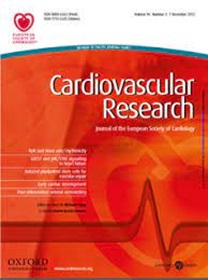RRAD-reduction reveals efficacy of targeting L-type calcium channel regulation for treatment of heart failure
IF 13.3
1区 医学
Q1 CARDIAC & CARDIOVASCULAR SYSTEMS
引用次数: 0
Abstract
Aims Heart failure with reduced ejection fraction (HFrEF) is a major health problem. Increasing L-type calcium channel (LTCC) activity deteriorates heart function; however, myocardial RRAD knockout (cRADΔ/Δ) instills tonic modulated LTCC current (ICa,L) that preserves healthy myocardium. Thus, we chose to challenge the dogma that enhanced trigger Ca2+ is maladaptive. The study objective was to test the hypothesis that modulated ICa,L in cRADΔ/Δ mice rescues dilated cardiomyopathy by providing tonic modulated trigger Ca2+. Methods and Results Mouse and human models were tested. The muscle lim protein knockout mouse (MLPKO) is a murine model of dilated cardiomyopathy (DCM) and HFrEF. The experimental timeline was to induce cRADΔ/Δ after onset of DCM (2.5 months of age) and follow subjects for up to 1-year. Longitudinal echocardiography and cardiac magnetic resonance imaging (CMR) showed that cRADΔ/Δ intervention rescued systolic function. Patch clamp recordings of isolated cardiomyocytes of MLPKO with cRADΔ/Δ demonstrated augmented LTCC activity, along with rescue of dysfunctional Ca2+ handling and sarcomere function. Bulk RNAseq of hearts demonstrated downregulated pathological signaling cascades and pro-hypertrophic gene expression which comported with the reduction in eccentric hypertrophy observed with gravimetrics, CMR, and echocardiography. RRAD knockdown effects translate from mouse to human heart. Ventricle slices from HFrEF patients were treated with lentiviral shRNA targeting RRAD and recapitulated the inotropic and lusitropic effects observed in the mouse model of DCM. Conclusions Induction of cardiomyocyte-restricted RAD knockout in MLPKO mice after onset of DCM rescued cardiac dysfunction and attenuated pathological remodeling. cRADΔ/Δ intervention provided positive inotropy and lusitropy and reverted transcriptional signatures towards healthy myocardium. This study introduces targeting myocardial RAD regulation of the LTCC as a novel therapeutic strategy for systolic heart failure.rrad降低揭示靶向l型钙通道调节治疗心力衰竭的疗效
目的心力衰竭伴射血分数降低(HFrEF)是主要的健康问题。l型钙通道(LTCC)活性升高使心功能恶化;然而,心肌RRAD敲除(cRADΔ/Δ)可灌注强直调节的LTCC电流(ICa,L),从而保持健康的心肌。因此,我们选择挑战的教条,增强触发Ca2+是不适应的。研究目的是验证cRADΔ/Δ小鼠中调节的ICa,L通过提供强直性调节触发Ca2+来拯救扩张型心肌病的假设。方法与结果采用小鼠和人模型进行实验。肌lim蛋白敲除小鼠(MLPKO)是一种扩张型心肌病(DCM)和HFrEF的小鼠模型。实验时间为DCM发病后(2.5个月大)诱导cRADΔ/Δ,随访1年。纵向超声心动图和心脏磁共振成像(CMR)显示cRADΔ/Δ干预恢复了收缩功能。膜片钳记录与cRADΔ/Δ分离的MLPKO心肌细胞显示LTCC活性增强,以及功能失调的Ca2+处理和肌节功能的恢复。心脏的大量RNAseq表现出病理信号级联和促肥厚基因表达的下调,这与重力、CMR和超声心动图观察到的偏心肥厚减少相一致。RRAD敲低效应从小鼠转移到人类心脏。用靶向RRAD的慢病毒shRNA处理HFrEF患者的脑室切片,再现了在DCM小鼠模型中观察到的肌力和弹力作用。结论诱导心肌细胞限制性RAD基因敲除可挽救MLPKO小鼠DCM发病后的心功能障碍,并减轻病理性重构。cRADΔ/Δ干预提供了正肌力变性和肌萎缩,并恢复了健康心肌的转录特征。本研究介绍了靶向心肌RAD调节LTCC作为收缩期心力衰竭的一种新的治疗策略。
本文章由计算机程序翻译,如有差异,请以英文原文为准。
求助全文
约1分钟内获得全文
求助全文
来源期刊

Cardiovascular Research
医学-心血管系统
CiteScore
21.50
自引率
3.70%
发文量
547
审稿时长
1 months
期刊介绍:
Cardiovascular Research
Journal Overview:
International journal of the European Society of Cardiology
Focuses on basic and translational research in cardiology and cardiovascular biology
Aims to enhance insight into cardiovascular disease mechanisms and innovation prospects
Submission Criteria:
Welcomes papers covering molecular, sub-cellular, cellular, organ, and organism levels
Accepts clinical proof-of-concept and translational studies
Manuscripts expected to provide significant contribution to cardiovascular biology and diseases
 求助内容:
求助内容: 应助结果提醒方式:
应助结果提醒方式:


